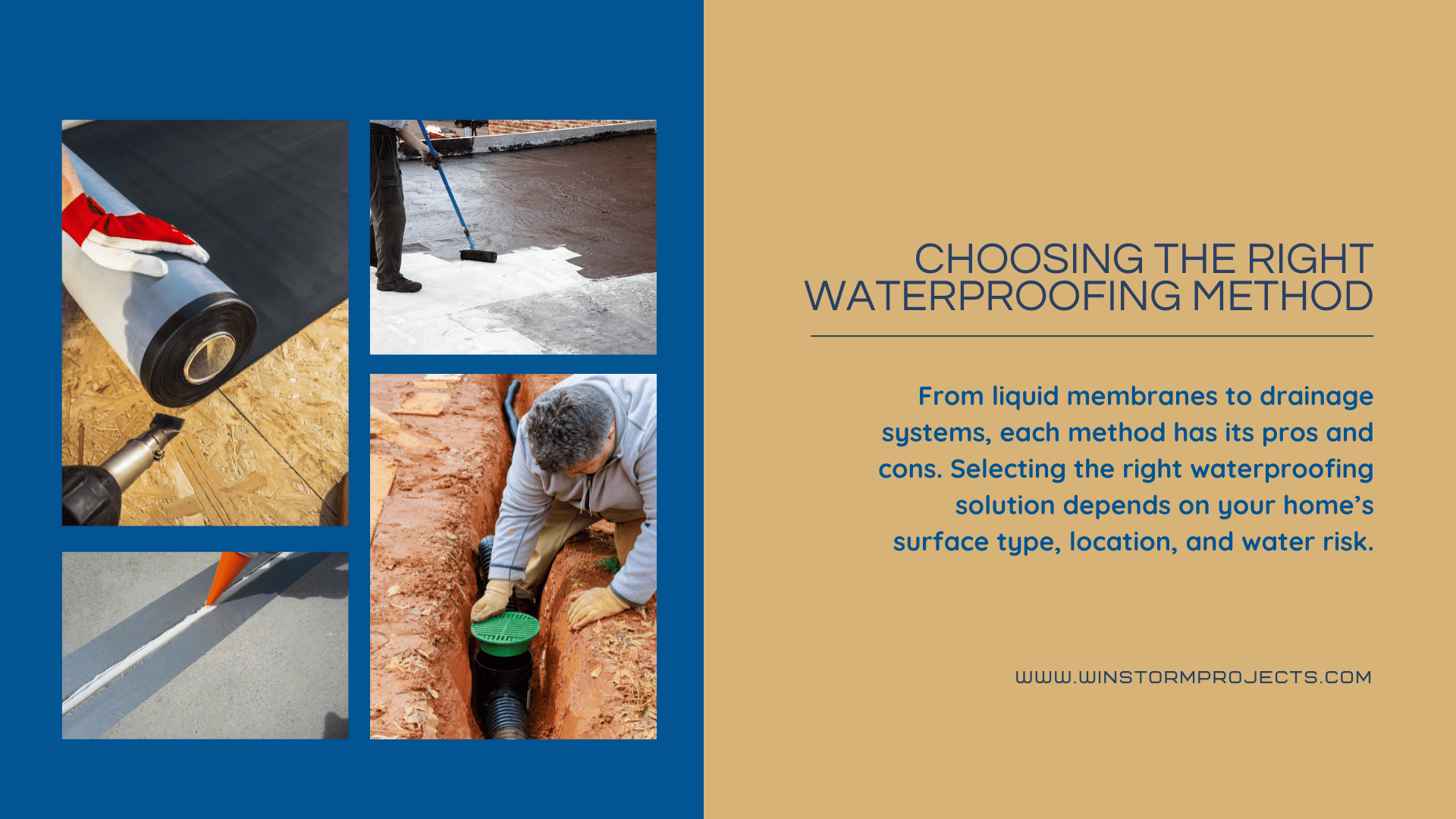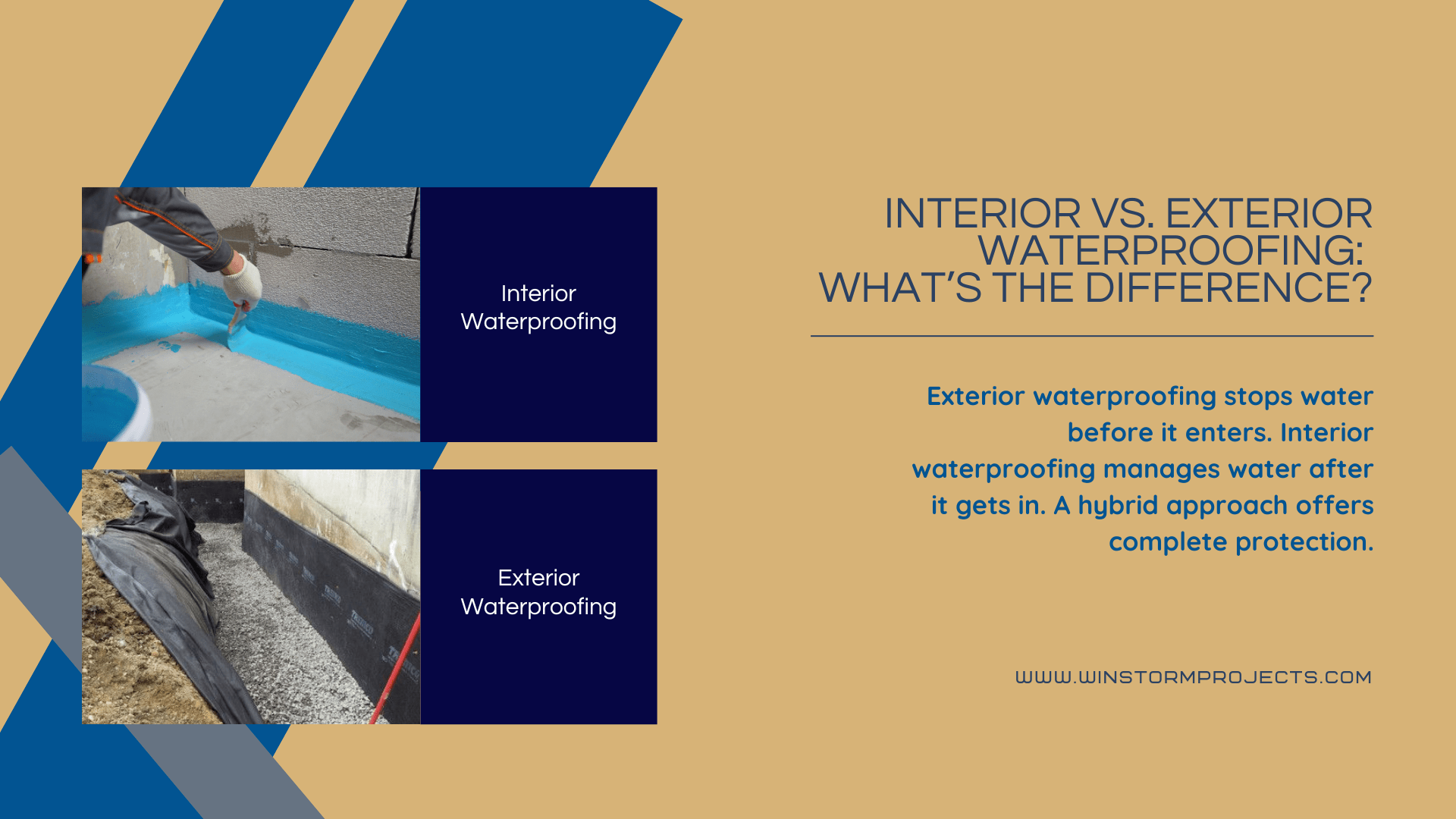Protecting outdoor structures from moisture damage isn’t just smart — it’s essential for Ontario homeowners. Between heavy rainfall and constant freeze-thaw cycles, surfaces like decks, patios, concrete walkways, and foundation walls are under stress year-round. Without proper waterproofing, even minor cracks or leaks can lead to costly repairs and long-term structural issues.
In this complete guide, we’ll walk you through proven exterior waterproofing methods and materials for Canadian homes. Whether you’re waterproofing a deck, sealing basement walls, or deciding between interior or exterior waterproofing systems, knowing your options helps you protect your home and your investment.
What Is Outdoor Waterproofing and Why Does It Matter?
Outdoor waterproofing refers to applying specific materials and techniques that prevent water from seeping into exterior structures like decks, patios, and foundation walls. It’s especially critical in Canada, where seasonal weather can lead to significant hydrostatic pressure, pooling, and surface cracking.
We use a mix of waterproofing membranes, sealants, and coatings designed to resist moisture, minimize erosion, and protect against mold growth. Skipping these measures leaves your home vulnerable — especially your basement, which is often the first area to show signs of water damage due to poor drainage or foundation leaks.
Types of Exterior Waterproofing Systems

Not all waterproofing options are created equal. Choosing the right waterproofing method depends on the surface you’re working with and your local climate.
Liquid Waterproofing Membranes
Applied like paint, liquid waterproof membranes form a seamless barrier across patios, driveways, and foundation walls. These flexible coatings expand and contract with surface movement, which is key in Ontario’s climate where freeze-thaw cycles are common.
They’re ideal for DIYers looking to seal cracks or apply a waterproofing system to concrete patios or retaining walls.
Sheet Waterproofing Membranes
Sheet membranes come in rolls and are installed across surfaces before being sealed. They’re highly resistant to punctures and ideal for exterior basement waterproofing or large-scale projects like wrapping foundation walls. For maximum protection, especially below grade, pairing them with a drainage system can help prevent water from accumulating near the base of your home.
Best Materials and Sealants for Effective Outdoor Waterproofing
Using high-quality waterproofing materials extends the life of outdoor surfaces and protects your home from water damage. Here are the top choices:
Waterproof Sealers for Concrete
These sealers penetrate the surface, creating a moisture-resistant barrier. They’re ideal for walkways, patios, and driveways, helping them resist water seepage, cracking, and salt damage during winter.
Waterproofing Paint
Outdoor waterproofing paint combines protection with curb appeal. Suitable for wood, concrete, and masonry, it’s perfect for updating decks or retaining walls while adding a protective coating.
Sealants for Joints and Cracks
A quality sealant helps fill gaps and joints where water could otherwise enter. Use this around windows, between stones, or along baseboards of decks and basement walls to block potential leaks.
Outdoor Wood Waterproofing Products
Decks and wood structures are particularly vulnerable. Apply a wood waterproofing treatment annually to resist rot, mildew, and mold growth — especially after heavy rainfall or snowmelt.
Benefits of Waterproofing Outdoor Structures
Investing in effective waterproofing is more than a preventative step — it’s a smart, long-term decision.
Protect Your Basement and Foundation
Basement water issues often start outside. Cracked concrete, poor grading, and clogged gutters allow moisture to pool around your foundation. This can lead to leaks and even compromise your structural integrity. Proper exterior waterproofing helps keep water away from your home’s vulnerable base.
Extend the Life of Outdoor Surfaces
Waterproofing protects against the freeze-thaw cycle, UV rays, and surface erosion. Whether it’s a deck, driveway, or exterior wall, sealing it properly helps it last longer — reducing the need for expensive repairs.
Improve Home Value and Peace of Mind
Homebuyers look for properties with dry, healthy basements and well-maintained outdoor features. Waterproofing your basement and exterior surfaces can increase property value and reduce stress over surprise issues caused by moisture.
Interior vs. Exterior Waterproofing: What’s the Difference?
When dealing with moisture, many homeowners ask: should I invest in interior basement waterproofing or exterior waterproofing? The answer depends on where the water is coming from.
- Exterior waterproofing stops water before it enters your home. It involves applying membranes, coatings, and sometimes installing a drainage system to prevent water from pressing against your basement walls.
- Interior waterproofing redirects water that has already entered, often through sump pumps, drainage channels, and interior sealants.
For complete protection, many homeowners choose a hybrid system that includes both exterior and interior waterproofing strategies.
DIY vs. Professional Waterproofing: What to Consider

DIY Waterproofing Projects
- Cost-effective for small jobs like applying sealant or waterproof paint.
- Ideal for homeowners comfortable with basic home repairs.
- Suitable for sealing cracks, coating decks, or applying waterproof sealers for concrete patios.
But without proper tools or knowledge, DIY attempts can fall short — leading to water damage or hidden leaks.
Professional Waterproofing Services
- Best for large-scale work or structural repairs (like waterproofing a basement from the outside).
- Professionals assess grading, soil type, and existing drainage systems.
- They install high-end waterproof membranes, manage excavation, and guarantee results — especially in high-risk areas.
Making the Right Call: If you’re unsure about your home’s risk level or see signs like basement dampness, wall cracks, or water pooling, it’s safer to call in an expert.
Choosing the Right Waterproofing Solution for Your Home
Consider Your Environment
Ontario homeowners deal with unique challenges: snowmelt, wet springs, and freezing winters. Whether you’re looking to waterproof a basement, deck, or patio, choose materials rated for local weather and soil conditions. Prioritize surfaces exposed to runoff or poor drainage.
Weigh the Costs
- Basic concrete sealers: $30–$60 per 5 litres
- Outdoor waterproofing paint: $20–$80 per gallon
- Professional waterproofing: Costs vary by surface and complexity but offer peace of mind and durability.
While DIY might save money short-term, professional waterproofing systems often yield better, longer-lasting protection — especially in areas prone to flooding or high hydrostatic pressure.
Final Thoughts: Protect Your Home with Smart Waterproofing
No matter the season, investing in the right waterproofing system helps you protect your home, maintain curb appeal, and prevent issues before they become serious problems. Whether you’re sealing a deck, adding a waterproof membrane to foundation walls, or updating your interior waterproofing, the right approach ensures long-term durability and comfort.
Frequently Asked Questions
What’s the most effective way to waterproof a basement?
A combination of exterior basement waterproofing (membranes, coatings, drainage) and interior basement waterproofing (sump pumps, sealants, drainage channels) provides the most complete protection.
Can I waterproof my deck myself?
Yes, especially with the right deck waterproofing products. Clean the surface thoroughly, use a high-quality sealant, and reapply yearly to protect against rot and UV damage.
What causes basement water issues?
Common causes include poor grading, clogged gutters, cracked foundation walls, or rising hydrostatic pressure. Fixing drainage systems and applying exterior waterproofing can help prevent water from entering.
How do I know if I need waterproofing?
Look for musty smells, cracks in walls or floors, peeling paint, or visible water. If you notice these signs, it’s time to consider awaterproofing project.

